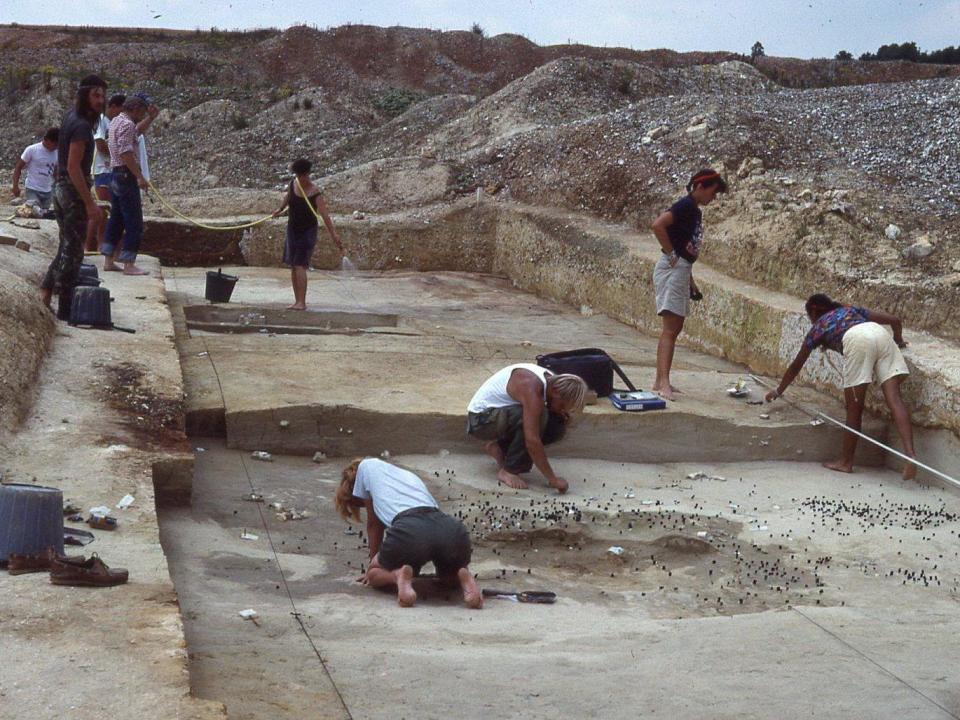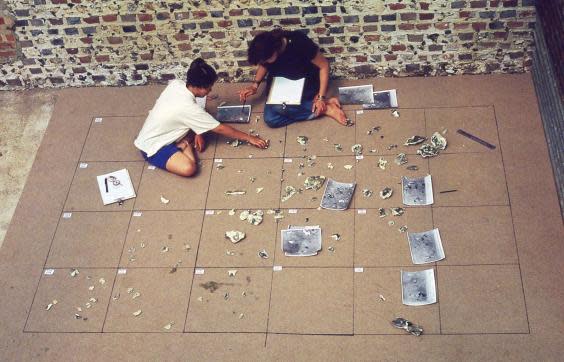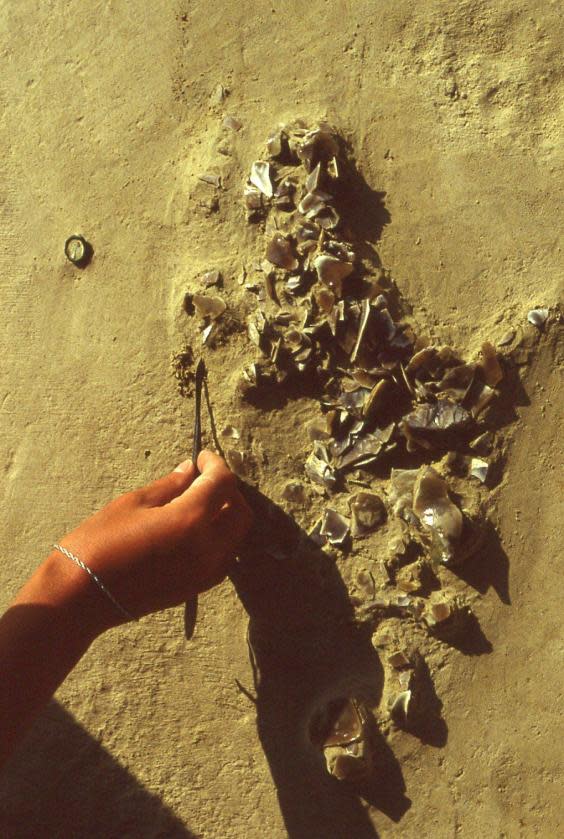Archaeologists able to reconstruct 'day in the life' of prehistoric ancestors half a million years on

Archaeologists have reconstructed a day in the life of a community of prehistoric people who lived on England's south coast half a million years ago.
It's the first time anywhere in the world that modern science has succeeded in reconstructing everyday life in such a high degree of detail that deep in prehistory.
Using complex forensic analysis of thousands of pieces of evidence, they have succeeded in piecing together what the 30 to 40 members of that community were doing over a roughly 6-8 hour period.
The site itself - near Boxgrove in West Sussex - is unique, as it preserved in situ unprecedentedly detailed evidence of a Stone Age feast – and the story of its preparation and aftermath.
Feasting was obviously central to human survival – so the archaeological investigation has been able to shed important new light on how, in practical terms, that survival occurred.
The nature of the site (and the source of several of the key tools) strongly suggests that the humans may well have decided to go there specifically to kill and butcher a large animal and nourish themselves on it.
The place was a very long yet narrow stretch of grassland, sandwiched at high tide between the sea and a high cliff – an ideal location for intercepting and then killing animal prey. Animals, especially herds of wild horses, would have been attracted to the area by the presence of cliff-base springs and probable freshwater ponds.
The distance between the sea (at mean high tide) and the rubble around the base of the 40 metre high cliff was potentially less than 100 metres – so it would only have taken up to ten people to effectively corral part of a herd and injure or kill one of its members.
The archaeological evidence also suggests that the humans came to the site fully prepared. They seem to have brought with them at least some previously made tools that would have been required to butcher their prey.
Although no archaeological evidence of the horse being killed has survived, it's conceivable that the animal was dispatched by the human hunters through the use of spears. The oldest known example of a spear in the world dates back to around 420,000 BC (in Clacton, Essex).
As soon as the horse had been killed, the small human community that had almost certainly dispatched it, began to butcher and eat it.

That process – involving the removal of its skin, the extraction of its offal, the separation of its flesh from its bones and the systematic breaking of parts of its skeleton – would have taken many hours.
A detailed analysis of the archaeological evidence has revealed for the very first time, anywhere in the world, how the butchery process involved virtually everybody in the group, almost certainly including children.
The study reveals how, deep in prehistory, human economic activity was a community-wide collaborative activity in which everybody played a part. And that, in turn, suggests that teaching and learning was inbuilt and totally integrated into their lives through participation in a way that no longer exists in most 21st-century human societies, where education is not normally based on economic participation and experience.
The pre-made artefacts that the humans brought with them included at least three flint cutting implements and at least one bone tool specifically needed for shaping and re-sharpening the freshly-made flint knives required to butcher the horse.
Once the horse was dead, the community set about using the bone tools to make eight additional flint knives (raw flint was available near the site because it had fallen out of the eroding adjacent chalk cliff).
To make all their new flint knives, the more skilled knife-makers sat in an extended semicircle around the dead horse – and used flint and bone tools to turn lumps of raw flint into extremely effective knives.
As soon as that knife-making process had been completed, the butchery operation seems to have begun.

Firstly, the horse's skin would have had to be removed. Then it is likely that the animal's kidneys, heart and liver were located, removed, shared out and eaten – along with the partially-digested contents of its stomach. The skull was then broken open and the brain consumed.
Next, the meat would have been removed from the bones – for 3 separate reasons. Quite apart from their wish to eat the meat (or take chunks of it away with them), the community would have craved the oil and the marrow inside the bones. The archaeological evidence reveals how they used large flint hammers to systematically shatter many of the bones, so as to extract every last morsel of highly nutritious oil and marrow.
However, it's not known whether they ate the meat in a totally unprocessed state – or used hammers to systematically break up the fibres and soften it. However, although fire may have been made by earlier humans in Africa and the Middle East, it is probable that people living in Europe at this time, did not know how to make fire - so they are unlikely to have been able to cook the meat.
Significantly, it wasn't just the specially made knives that were used to butcher the horse. Sharp flint flakes from the knife-manufacturing process were taken from all eight main flint-knife-making locations (in the rough semicircle) and then used in the butchery process – probably by less skilled adults and children. In total, at least 31 of those sharp flakes were deliberately taken from the knife-manufacturing locations and used in that way.
Last but not least, the group may well have taken the horse's skin away with them. The potential evidence for that is the complete absence of the animals feet at the butchery site. It is known that when entire skins were removed from animals in prehistory, the hooves were often removed as well – still attached to the skin (possibly as useful handles). The absence of the feet also suggests that the skin was removed with substantial care – presumably so that it could subsequently be used as clothing or bedding or perhaps even as windbreaks or for any tent-like structures (although no surviving evidence for such structures exists as early as this anywhere in the world)

The evidence for pre-planning, social cooperation, participation and education in this long-lost day in the life of a long-forgotten half a million year old human community is helping archaeologists to piece together a particularly crucial period in the story of humanity.
The era around half a million years ago (Boxgrove itself is 480,000 years old) was the time that many scholars believe that human cognitive evolution began to speed up.
Some academics have even suggested that it is the period during which language first begins to develop. It is also the time when, at least in Africa, humans begin to use pigments – presumably for some form of decoration or art.
Although the horse butchery site represents a day – or even less than a day – in the life of the small community involved, it has also provided evidence as to how the day's events helped them over succeeding days and weeks.
A detailed analysis of the material at the site strongly suggests that they took away substantial quantities of meat, the skin, the leg tendons and the largest bone in each of the animals four feet (for probable use as knife-shaping and sharpening tools). The evidence also suggests that they removed the rib cage intact – perhaps as a ready-made container in which to carry large chunks of meat to their home base.
It's not known where that home base was located – but just 500 metres away. There was a probable break in the cliff-line through which they would have been able to have access to the cliff top and the pastures and forests behind it.

After they had abandoned the butchery site, successive high tides would have rapidly covered the horse's remains with silt and sand – but not before wolves and hyenas have had an opportunity to gnaw at the remaining bones. Their teeth marks have been found on some of the skeletal material.
The people whose lives have been recorded by the archaeological investigation belonged to a now-long-extinct species of humans – possibly a species now known as Homo heidelbergensis or possibly an early form of Neanderthal. New research is currently underway to try to solve that particular puzzle.
However, what is known is that the people of Boxgrove were extremely well-built and very strong. At another nearby site (within the Boxgrove complex), research has been carried out on a human's lower left leg bone. The dimensions and nature of that bone has led scientists to conclude that it's original 'owner' was almost six-foot tall and weighed in at around 90 kilos. Built like a rugby player, that individual's lower leg bone was extremely well developed – almost certainly at least partly through very frequent intense use. Without doubt, he (or possibly she) and the rest of the community at Boxgrove would have needed an ability to run very fast for short distances - to hunt game, perhaps to escape from human enemies and definitely to escape from animal predators.
The Boxgrove butchery site study, led by archaeologist Matthew Pope, of University College London's Institute of Archaeology, is published today (Wednesday) in a new book ‘The Horse Butchery Site’, published by Spoilheap Publications.
"Our detailed investigation has brought into focus people from the deep past who usually remain invisible," said Dr Pope.
Co-author, Simon Parfitt said that the bone artefacts are "some of the earliest non-stone tools found in the archaeological record of human evolution".
"They would have been essential for manufacturing the finely made flint knives found in the wider Boxgrove landscape,” he said.
The project has been funded by Historic England, the Arts and Humanities Research Council , the Natural History Museum, the Calleva Foundation and the British Museum.
The investigation into the Boxgrove butchery site started in 1988 and was completed in 2019.

